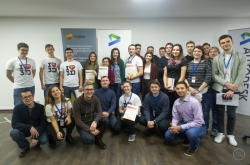BIM
Building Information Modeling (BIM) technology lets users create a complete informational description of a construction project; the system compiles information on the properties and parameters of all elements of a building. Using this data, specialists can draw up blueprints, schedule construction work, and predict issues.
One of its greatest advantages is that it presents a dynamic model that reflects all the possible effects of various factors, helping find the optimal solution in order to save resources. BIM can also be used to model the operation of all engineering systems, choose materials and even calculate the economic aspects of construction. It can also track the status of construction in real time and predict various outcomes in the event of changes to the structure.
“Modeling a system of interconnected elements helps us save time when designing a building and preparing the necessary paperwork. Any change has an instant effect on the entire model. Imagine that if, in the process of design, you remove a window, you will no longer have to rewrite all of the documentation; it’s already been done automatically. BIM can also help check for collisions; by combining a model of the building and its communications network, you’ll see whether any elements conflict with each other,” explains Filipp Perepelitsa, Head of the Autodesk-ITMO International Education and Science Center.

BIM In Russia
In the recent years, more companies have embraced BIM in their work. The matter of introduction and regulation of the technology has also been spoken about at the government level. Not long ago, the Russian President has charged the Prime Minister Dmitry Medvedev with ensuring the transition of the construction industry to BIM technology within a year.
“There had already been movements towards establishing some regulation regarding BIM in civilian construction,” comments Perepelitsa, “but now that this order is public, we can say that if a decision has been made on such a high level, then things are starting to move forward. Market experts are ready to start using this technology and see it as the future. The experience of the UK, Singapore and others may serve as a motivation for a wider application of BIM.”
The industry interest is also reflected in the actions of major Russian software developers. Companies 1C and Askon have already begun developing their own BIM software.

Specialists for the new trade
The government order includes a point about the training of information modeling specialists. Since last year, ITMO University has been training such specialists as part of the occupational retraining program “Project Development and Management with Use of Building Information Modeling Technology”. The program was launched together with Etalon Group’s research center.
The course lasts 265 academic hours and includes seven modules, one of them being a graduation project. Each module is dedicated to particular skills and technologies. Classes are held by staff of ITMO University and specialists from the university’s partner companies.
Upon graduation, students receive an occupational retraining diploma, which lets them work as certified professionals, as well as an Autodesk certificate.
Key changes and new modules
This year, the program has been expanded with a new module developed by ITMO University and its partner, the company «Geodezicheskie Pribori», a supplier of surveying equipment.

ITMO University began working with the company in 2010. As part of the new module “Surveying Operations Management in Construction”, students learned how to conduct an as-built survey with just one surveyor, perform analysis and create models for use on the construction site. Experts from the company came in as lecturers; some classes were held at the company’s premises.
The program “Project Development and Management with Use of Building Information Modeling Technology” is designed for working specialists: designers and those employed at construction companies, with existing construction experience. As the students noted, the skills acquired here will let them further expand their professional interests.
“This course is largely for designers. But I enjoyed learning about BIM technologies. Of note to me were the modules that dealt with project work, and the 3D-scanning classes we had at the company,” says Evgeny Khromov, who participated in the course, “BIM is very promising, especially in the power industry, where it’s only becoming a thing, and I plan to develop and apply the skills I acquired.”
Graduates of the program are given a state-standardized occupational retraining diploma that allows them to work on BIM projects, as well as an Autodesk certificate.
“Right now, I work as a road engineer, but I plan to get into civil construction,” says engineer Dmitry Alekseev, “I wasn’t familiar with BIM before, but I looked it up online in preparation for the course. I also checked out relevant literature and kept track of various regulations and developments in the area. I want to start working with BIM and use what I learned here in practice.”
Prospects

This year’s course ended on July 17, and the new program launches in September. As Filipp Perepelitsa notes, the program will introduce a new module designed in collaboration with Renga Software.
“The course is always developing because new technologies and trends emerge all the time. We signed a partnership agreement with Renga and we hope to develop that relationship even further. The new module will include Russian-made software and thus familiarize the students with an alternative to foreign software,” says Perepelitsa.
In December, the program will also introduce a new course on the use of informational models in maintenance; therefore, the program will then encompass the entire lifecycle of a building. In addition, the experience gained through the program was used to draw up a Master’s degree program of the same name that has been approved by ITMO’s Teaching and Methodological Council.





